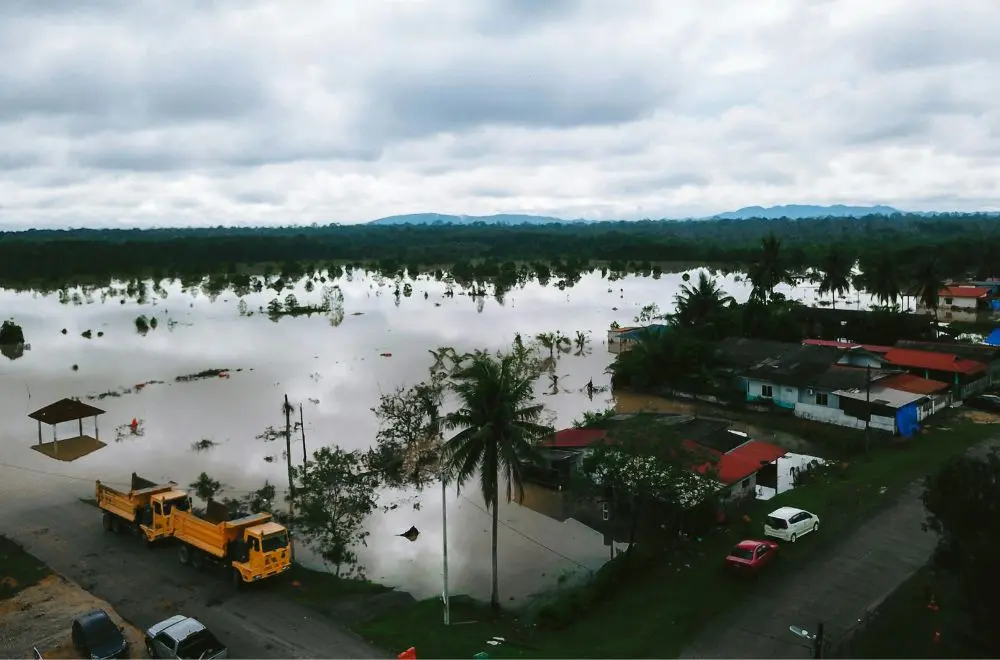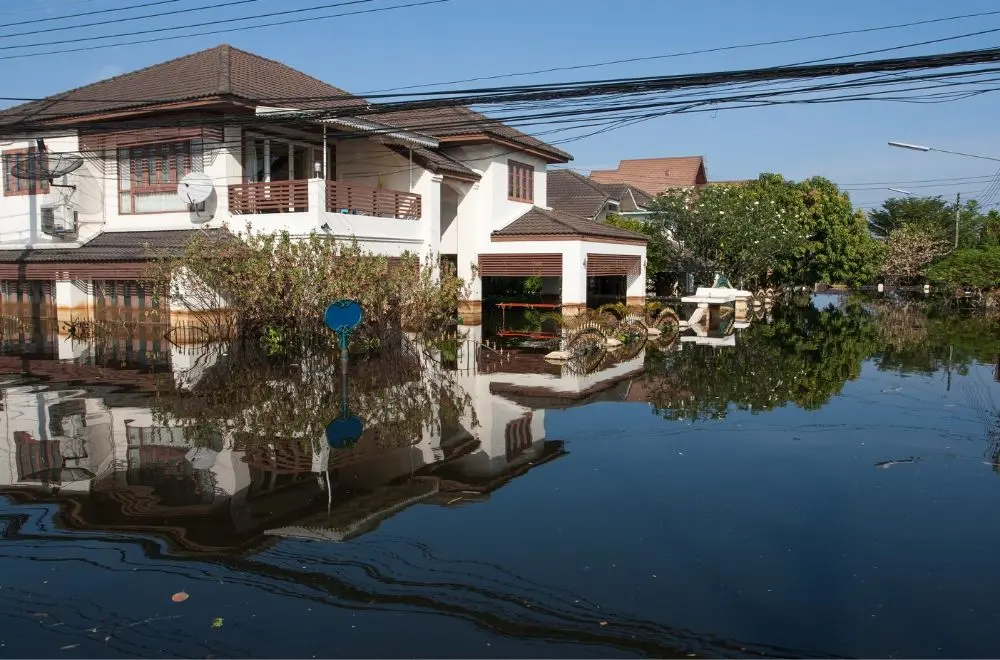Getting the best quote for flood insurance in California starts with understanding how risk, regulation, and local geography work together. Flooding in California isn’t limited to coastal zones — atmospheric rivers, urban runoff, levee breaks, and rapid snowmelt can devastate inland neighborhoods as well. Yet many homeowners assume their regular policy covers flood damage when, in fact, it doesn’t. Flood insurance is what keeps an emergency from becoming a financial catastrophe.
This guide breaks down how flood insurance works in California, what affects your quote, and how to choose between NFIP and private market options. As an independent agency, Old Harbor Insurance Services helps homeowners secure accurate, competitive flood quotes that reflect their true exposure — not just their ZIP code.
Why Flood Insurance Matters in California
Flooding in California is both underestimated and misunderstood. The state’s diverse geography means every region faces its own version of water risk — from coastal storm surges to inland levee failures.
The changing nature of flood risk
California’s flood challenges have evolved. Atmospheric rivers now routinely bring days of torrential rain to the coast and Central Valley, dropping more than a foot of water in short bursts. Urban flooding has become a year-round problem as paved surfaces limit drainage, forcing rainwater into streets and basements. In the Central Valley, decades-old levees protect millions of residents, yet many remain vulnerable to overtopping or failure during high runoff seasons. Snowmelt surges add another variable — spring warming in the Sierra Nevada can turn creeks into rivers overnight.
Why your homeowners policy won’t help
A standard homeowners policy specifically excludes flood damage — defined as water rising from outside the structure and entering the home. That means whether the cause is a river overflow, heavy rain, or clogged storm drains, your claim will be denied unless you have a dedicated flood policy. Flood insurance bridges this critical gap, covering the most expensive and destructive kind of loss most homeowners will ever face.
How Flood Insurance Works in California

Flood insurance here follows national guidelines, but how it’s priced, required, and applied depends on state-specific conditions.
The NFIP (National Flood Insurance Program)
Most Californians buy flood insurance through the National Flood Insurance Program (NFIP), managed by FEMA. The NFIP provides up to $250,000 for building coverage and $100,000 for personal property, using a standardized policy available nationwide. It’s required for homes in Special Flood Hazard Areas (SFHAs) with federally backed mortgages. Premiums are now calculated using Risk Rating 2.0, a new model that looks at each property’s distance to water, elevation, foundation type, and cost to rebuild. The NFIP’s biggest advantage is stability — it’s government-backed, widely accepted by lenders, and guaranteed renewable.
Private flood insurance
Private flood insurers have become a strong alternative to NFIP. They often offer:
- Higher coverage limits (up to or beyond $1 million)
- Replacement cost coverage on both structure and contents
- Loss-of-use or additional living expense (ALE) coverage
- Shorter waiting periods (as little as 7–15 days)
- Customizable deductibles and faster claims handling
Private flood policies tend to favor homeowners in moderate-risk zones or those with elevation advantages. They can also complement NFIP coverage by providing excess protection.
Mandatory coverage requirement
If your property lies in a Zone A or Zone V flood zone, and your mortgage is federally backed, flood insurance is mandatory. Lenders are required to enforce this rule to protect both borrower and collateral. However, even homeowners outside these areas are encouraged to buy Preferred Risk Policies, which offer lower-cost coverage for homes in moderate- or low-risk areas.
Understanding FEMA Flood Zones and California Hotspots

To get an accurate quote, you first need to understand your flood zone — and how local geography amplifies the threat.
FEMA flood zone basics
FEMA divides the country into zones based on flood probability:
- Zone A: High risk, typically near rivers and floodplains.
- Zone AE or VE: Coastal and high-velocity water zones with stricter elevation requirements.
- Zone X (shaded): Moderate risk, often near waterways or drainage systems.
- Zone X (unshaded): Minimal risk — but not no risk. Roughly 20% of all flood claims come from these areas.
California’s flood-prone regions
Flooding looks different depending on where you live:
- Sacramento & Central Valley: Built on former marshland, protected by 1,600 miles of levees that are increasingly stressed by heavy runoff.
- Bay Area & San Francisco Peninsula: Coastal surge meets aging stormwater infrastructure. Low-lying areas like San Mateo, Marin, and Alameda counties face both tidal and rainfall flooding.
- Los Angeles Basin: Flash floods flow through concrete channels after storms, especially near recent wildfire burn scars.
- San Diego County: Riverine flooding affects Mission Valley and inland waterways; coastal erosion amplifies risk for beachside properties.
| Region | Dominant Flood Type | Typical Risk Level |
| Central Valley | Levee breaks, snowmelt runoff | Very High |
| Bay Area | Coastal surge, drainage overflow | High |
| Los Angeles Basin | Flash floods, urban runoff | Moderate–High |
| Inland Empire | Burn scar flooding, urban flash | Moderate |
| San Diego | River and coastal flooding | Moderate–High |
Factors That Affect Your California Flood Insurance Quote
Two homeowners on the same block can pay drastically different premiums. The difference lies in data — your home’s elevation, foundation, and construction features all shape your quote.
Property-specific factors
- Flood zone designation and proximity to rivers, creeks, or coastlines
- Elevation relative to the base flood elevation (BFE)
- Foundation type: slab, raised, or basement — basements often cost more to insure
- Building age and code compliance: newer homes built to floodplain standards often qualify for lower rates
- Elevation Certificate (EC): official verification of your property’s elevation; key for NFIP accuracy
Coverage and policy factors
- Building and contents limits: Higher limits mean higher premiums but better recovery potential.
- Deductible selection: A higher deductible lowers your annual cost but increases what you pay out of pocket.
- Replacement Cost vs. Actual Cash Value: Determines whether depreciation is deducted at claim time.
- Endorsements: Coverage for detached structures, pool equipment, or loss of use can affect price.
Market and regulatory factors
- FEMA Risk Rating 2.0: Moves beyond flood zones to assess true property-level risk. Homes once “low risk” can see premium adjustments based on proximity to water or topography.
- Private insurer modeling: Proprietary algorithms that weigh recent rainfall data, soil permeability, and microclimate risk can yield discounts for well-positioned homes
Comparing NFIP vs. Private Flood Insurance
Both cover flood losses, but they’re not interchangeable. The right choice depends on your property’s location, structure, and lender requirements.
| Feature | NFIP (FEMA) | Private Market |
| Max Dwelling Limit | $250,000 | Up to $1,000,000+ |
| Contents Coverage | $100,000 | Customizable |
| Deductible Range | $1,000–$10,000 | $500–$50,000 |
| Additional Living Expense | Not available | Often included |
| Waiting Period | 30 days | 7–15 days |
| Coverage Type | Actual Cash Value | Replacement Cost |
| Regulation | Federal (FEMA) | California DOI or surplus lines |
| Ideal Fit | Federally required or high-risk homes | Mid- to high-value homes or elevation advantage |
Hybrid strategies
Many homeowners blend both approaches: keeping NFIP coverage for lender compliance while adding private excess coverage for contents or ALE. Once a mortgage is paid off, switching entirely to private flood can unlock better pricing and more flexible terms.
How to Get an Accurate Flood Insurance Quote in California

The most accurate flood quote is based on verified property data, not online averages.
Step-by-step guide
- Locate your flood zone — Use FEMA’s Flood Map Service Center or your local planning department.
- Gather property details — Year built, square footage, number of stories, and type of foundation.
- Obtain an Elevation Certificate — Especially for homes in high-risk zones; can lower premiums substantially.
- Decide on coverage scope — Structure only, structure + contents, or full coverage with ALE.
- Select deductible and limits — Align with rebuild cost and savings, not just market value.
- Compare multiple quotes — Independent agents like Old Harbor can run both NFIP and private options.
- Note activation timeframes — NFIP coverage takes 30 days to begin, while private insurers can activate sooner.
Common mistake to avoid
Don’t use an estimated rebuild cost based on market value. Rebuilding a home in California often costs 30–50% more per square foot than its sale price suggests.
Smart Ways to Lower Your Flood Insurance Premium
While you can’t control the weather, you can control your flood risk profile—and that means paying less over time.
Actionable strategies
- Get an Elevation Certificate: Reduces uncertainty and often leads to premium reductions.
- Elevate equipment: Raise HVAC systems, water heaters, and electrical panels above BFE.
- Add engineered flood vents: Prevents structural collapse by equalizing water pressure.
- Maintain floodplain compliance: Keep documentation current with city building departments.
- Bundle policies: Pair flood insurance with homeowners or umbrella coverage for multi-policy discounts.
- Retrofit and maintain grading: Slope your property to direct water away from the foundation.
- Consider private markets: Flexibility in coverage and deductibles can significantly lower your rate.
Quote-Ready Checklist
The more information you provide upfront, the more accurate your quote—and the faster your policy can be issued.
- Full property address and ZIP
- Year built and construction type
- Foundation type (slab, raised, basement)
- Square footage and number of stories
- Elevation certificate (if available)
- History of flood claims or water damage
- Mortgage lender information (if applicable)
- Desired coverage limits for structure and contents
- Deductible preference
- Optional add-ons: loss of use, detached structures, pool equipment, or landscaping
Having this ready helps an independent agent like Old Harbor match your property to the most competitive carrier in minutes.
Old Harbor Insurance — Comparing Flood Quotes the Right Way
Getting a flood quote shouldn’t be a guessing game. Old Harbor Insurance combines local insight, advanced mapping tools, and carrier access to deliver clarity where others offer averages.
Why homeowners trust Old Harbor
We specialize in California-specific flood risk, from Sacramento’s levee systems to Los Angeles’s flash-flood corridors. Our agents understand how FEMA maps, Risk Rating 2.0, and private underwriting models intersect—and how to position your property for the best rate.
What makes our process different
Old Harbor compares both NFIP and private flood carriers side by side, giving you transparent pricing, deductible options, and coverage scenarios. We help you interpret Elevation Certificates, identify premium-saving retrofits, and choose the structure and contents limits that truly reflect your rebuild cost.
We don’t stop at quoting; we help you maintain compliance with lender and FEMA requirements, so your coverage never lapses when you need it most. From first quote to claim support, Old Harbor ensures you understand every number on your policy and every option at renewal.
When the next storm system hits, peace of mind won’t come from hoping your area stays dry — it’ll come from knowing your protection is already in place.
Conclusion — Protect Your California Home from Rising Flood Risks
Flooding is becoming a regular part of California’s weather cycle, not a once-in-a-lifetime event. Whether you live in a known floodplain or a so-called “low-risk” zone, having flood insurance means you’re financially ready for what nature delivers next. Compare NFIP and private flood options, check your coverage limits, and make sure your deductible aligns with your emergency fund.
For expert guidance, contact Old Harbor. Our advisors will walk you through each option, explain how risk rating affects your quote, and design coverage that fits your home, your risk zone, and your peace of mind.
Frequently Asked Questions (FAQs)
1) Is flood insurance required in California?
Flood insurance is mandatory for properties in FEMA’s Special Flood Hazard Areas (Zones A or V) if the mortgage is federally backed. Even outside those zones, policies are strongly encouraged because 1 in 5 flood claims come from “low-risk” areas.
2) How much does flood insurance cost in California?
Costs range from about $300 in low-risk areas to over $3,000 in high-risk zones. Elevation, foundation type, and distance from water are the strongest pricing factors under FEMA’s Risk Rating 2.0 model.
3) Can I use private flood insurance instead of NFIP?
Yes. Private flood insurance is accepted by most lenders and often offers higher limits, replacement-cost coverage, and shorter waiting periods. Old Harbor can help you compare both markets easily.
4) Does flood insurance cover flash floods or mudslides?
Flood policies cover surface water entering the home from outside sources, including flash floods. Mudslides and earth movement are excluded but can sometimes be added through special endorsements.
5) How long does it take for flood coverage to begin?
NFIP policies take 30 days to activate after purchase. Private policies usually begin within 7 to 15 days. Plan ahead—coverage must be active before a storm warning is issued.

